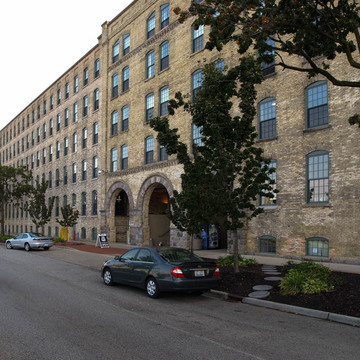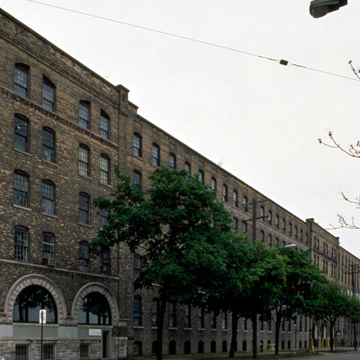You are here
The Boardwalk Building (Berkey and Gay Furniture Company)
The Berkey and Gay Furniture Company Factory, now The Boardwalk Building, marks the importance of furniture manufacturing in Grand Rapids from 1870 to 1929 and of mixed-use redevelopment to the economic and social health of the city today.
In 1873, Julius Berkey and George Gay formed the Berkey and Gay Furniture Company. Berkey formerly manufactured sashes, doors, and blinds. Gay owned half interest in a predecessor furniture company. In 1882 Berkey and Gay built and equipped a factory complex of manufacturing, office, warehouse, shipping, and showroom space that occupied three-square blocks at 178 Canal Street (now Monroe Avenue at Michigan Street). Lumberyards were at the site. Eventually, in 1911, after merging with the Oriel Cabinet Company, maker of fancy and art furniture, Berkey and Gay acquired the former Oriel Cabinet Company factory that was the initial structure in the additive building on Monroe Street. Using the slogan “For Your Children's Heirlooms,” the company produced furniture and confirmed the prominence of Grand Rapids as the “Furniture Capital.” That reputation was established earlier when Berkey and Gay Furniture Company, then the largest furniture manufacturer in the city, and three other Grand Rapids furniture manufacturers exhibited at the 1876 Centennial in Philadelphia.
The factory was built in three phases: a large U-shaped structure that the Oriel Cabinet Company put up in 1892 became the Berkey and Gay Furniture Company Plant No. 1 when the furniture makers merged; an addition that enclosed the U shape and created the south courtyard in 1912; and a U-shaped addition to the north that created the north courtyard in 1912.
The sprawling, five-story, yellowish-white brick building is extraordinary, for it was contemporary with H. H. Richardson's Marshall Field Wholesale Store of 1885–1887. The company's superb woodworking facilities and concern for the workers' welfare had few equals at this time. The structure is arranged around two open interior courtyards that provided ample light and ventilation. Like this building, the Adler and Sullivan Auditorium Building in Chicago (1886–1890) employed the prominent large arched opening at the street level, a series of windows to effect a vertical movement, and a terminating parapet. Whereas the Adler and Sullivan work is refined and elegant, the Berkey and Gay factory is direct and robust.
Pioneer Construction led the rehabilitation of the 500,000-square-foot former factory into The Boardwalk Building of 373 apartments, a restaurant, offices, and retail space, thereby launching the rebirth of the city's near north side. This project coupled with the rehabilitation of 100,000 square feet of the American Seating Company factory complex on the city's near north and west sides into urban residences, and working and entertainment facilities represented a major investment. Together, in 2004, the projects were the recipient of the governor's award for their mixed use of housing, commercial, and recreational facilities in close proximity and that revitalized declining neighborhoods. With exposed brick walls, massive oak beams, lofty ceilings, and windows that afford views of the river or one of two central courtyards with atria, the rehabilitation respects and enhances the craftsmanship of the original Berkey and Gay building.
Writing Credits
If SAH Archipedia has been useful to you, please consider supporting it.
SAH Archipedia tells the story of the United States through its buildings, landscapes, and cities. This freely available resource empowers the public with authoritative knowledge that deepens their understanding and appreciation of the built environment. But the Society of Architectural Historians, which created SAH Archipedia with University of Virginia Press, needs your support to maintain the high-caliber research, writing, photography, cartography, editing, design, and programming that make SAH Archipedia a trusted online resource available to all who value the history of place, heritage tourism, and learning.
























